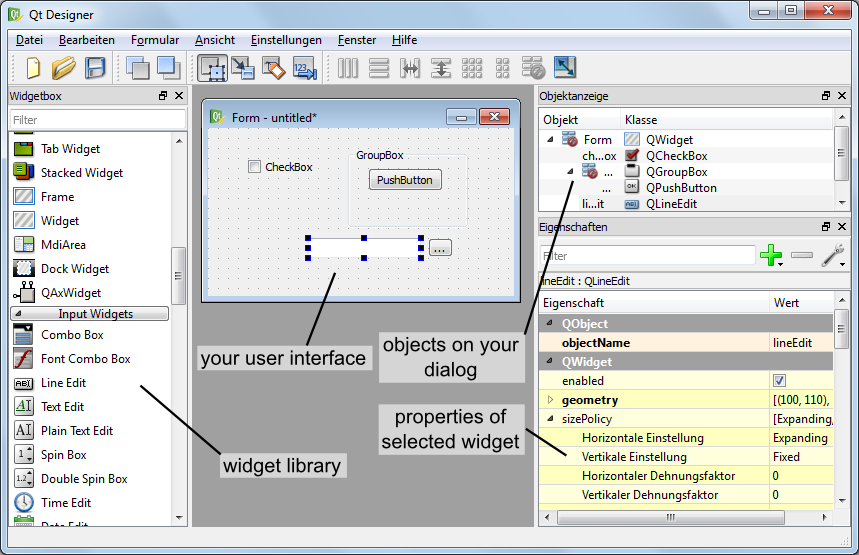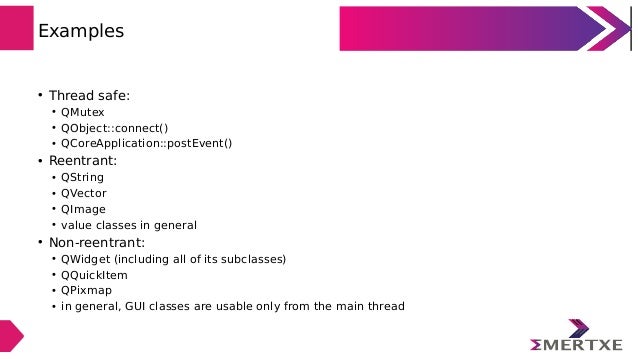For any C developer who's used Qt, we've grown to love the Signals/Slots idiom it presents for creating clean Observer code. However, it relied on the Qt Moc pre-compiler tool, which meant any project that wanted to use this feature had to use follow along with the Qt idiom, which really made Qt applications look potentially foreign despite being written in C. Asynchronous events are thread-safe. In fact, cross-thread signals and slots are based on asynchronous event. When a signal is emitted from an object in one thread to an object in another thread, there will be actually an event sent between the threads, assuming that the connection type is either automatic or queued.
Introduction
Remember old X-Windows call-back system? Generally it isn't type safe and flexible. There are many problems with them. Qt offers a new event handling system: signal-slot connections. Imagine an alarm clock. When alarm is ringing, a signal is being sent (emit). And you're handling it in a slot.
- Every QObject class may have as many signals and slots as you want
- You can emit signals only from within that class, where the signal is located
- You can connect signal with another signal (make chains of signals);
- Every signal and slot can have unlimited count of connections with other.
- ATTENTION! You can't set default value in slot attributes e.g. void mySlot(int i = 0);
Connection
You can connect signal with this template: Tips para poker texas holdem.

QObject::connect (
);

You have to wrap const char * signal and const char * method into SIGNAL() and SLOT() macros.
And you also can disconnect signal-slot:

QObject::disconnect (
);
Deeper
Widgets emit signals when events occur. For example, a button will emit a clicked signal when it is clicked. A developer can choose to connect to a signal by creating a function (a slot) and calling the connect() function to relate the signal to the slot. Qt's signals and slots mechanism does not require classes to have knowledge of each other, which makes it much easier to develop highly reusable classes. Since signals and slots are type-safe, type errors are reported as warnings and do not cause crashes to occur.
Qt Signal Slot Example
For example, if a Quit button's clicked() signal is connected to the application's quit() slot, a user's click on Quit makes the application terminate. In code, this is written as
connect(button, SIGNAL (clicked()), qApp, SLOT (quit()));
Connections can be added or removed at any time during the execution of a Qt application, they can be set up so that they are executed when a signal is emitted or queued for later execution, and they can be made between objects in different threads.
Qt Signals And Slots Thread Safe Java

The signals and slots mechanism is implemented in standard C++. The implementation uses the C++ preprocessor and moc, the Meta Object Compiler, included with Qt. Code generation is performed automatically by Qt's build system. Developers never have to edit or even look at the generated code.
Qt Signals And Slots Tutorial
In addition to handling signals and slots, the Meta Object Compiler supports Qt's translation mechanism, its property system, and its extended runtime type information. It also makes runtime introspection of C++ programs possible in a way that works on all supported platforms.
Water's Edge Buffet So many dining options to delight your taste buds Enjoy Magnificent Cuisine at the Water's Edge Buffet Restaurant. Our award-winning All-You-Can-Eat Buffets feature an assortment of finely prepared entrees and desserts open 7 days a week! Daily Buffet Specials Not a member yet? We love to reward your loyalty!Grab your One Rewards.

QObject::connect (
);
You have to wrap const char * signal and const char * method into SIGNAL() and SLOT() macros.
And you also can disconnect signal-slot:
QObject::disconnect (
);
Deeper
Widgets emit signals when events occur. For example, a button will emit a clicked signal when it is clicked. A developer can choose to connect to a signal by creating a function (a slot) and calling the connect() function to relate the signal to the slot. Qt's signals and slots mechanism does not require classes to have knowledge of each other, which makes it much easier to develop highly reusable classes. Since signals and slots are type-safe, type errors are reported as warnings and do not cause crashes to occur.
Qt Signal Slot Example
For example, if a Quit button's clicked() signal is connected to the application's quit() slot, a user's click on Quit makes the application terminate. In code, this is written as
connect(button, SIGNAL (clicked()), qApp, SLOT (quit()));
Connections can be added or removed at any time during the execution of a Qt application, they can be set up so that they are executed when a signal is emitted or queued for later execution, and they can be made between objects in different threads.
Qt Signals And Slots Thread Safe Java
The signals and slots mechanism is implemented in standard C++. The implementation uses the C++ preprocessor and moc, the Meta Object Compiler, included with Qt. Code generation is performed automatically by Qt's build system. Developers never have to edit or even look at the generated code.
Qt Signals And Slots Tutorial
In addition to handling signals and slots, the Meta Object Compiler supports Qt's translation mechanism, its property system, and its extended runtime type information. It also makes runtime introspection of C++ programs possible in a way that works on all supported platforms.
Water's Edge Buffet So many dining options to delight your taste buds Enjoy Magnificent Cuisine at the Water's Edge Buffet Restaurant. Our award-winning All-You-Can-Eat Buffets feature an assortment of finely prepared entrees and desserts open 7 days a week! Daily Buffet Specials Not a member yet? We love to reward your loyalty!Grab your One Rewards. Just east of Port Perry, the Great Blue Heron Casino is a unique casino featuring separate table and slot areas that provide guests with an intimate, yet exciting gaming environment.
To make moc compile the meta object classes don't forget to add the Q_OBJECT macro to your class.